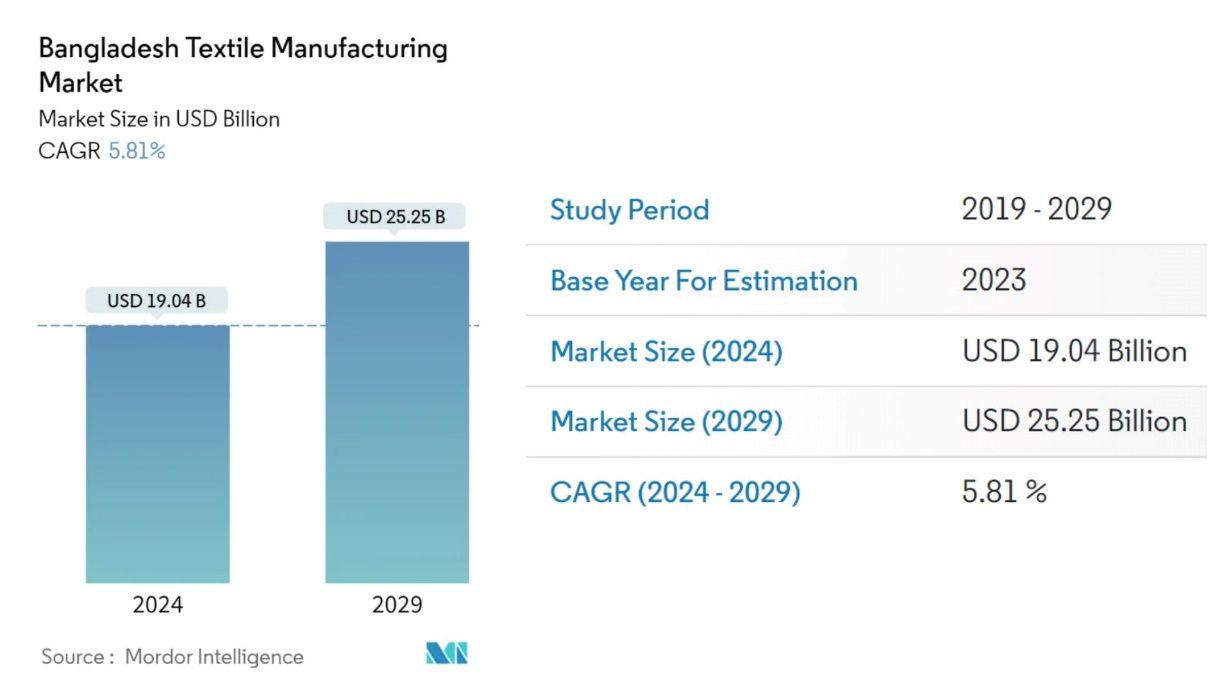With nearly 40 turnkey plants built for the textile industry, Hydrotech Engineering contributes each year to recover over 40,000,000 m3 of water
From February 1st to 4th, 2024, we will be at the DTG – Textile and Garment Fair in Dhaka, Bangladesh, at booths 8-048, 8-500, 8-535 Hall 8, with our local partner Sun Trading Co (BD). Click here to book a meeting at the booth with one of our top experts in technologies such as ZLD (Zero Liquid Discharge) and processes for the effective treatment and recovery of water for your industry.
When addressing the textile industry, Asia emerges clearly as the main player in the sector. This prominent position is because the region is the hub of global textile production, with resulting environmental impacts from the release of polluted water into the environment affecting both the surrounding ecosystem and people’s health.
In this article, we will explore solutions adopted to mitigate the environmental impact of this constantly growing sector and analyze market perspectives. We will start with a brief update on the Asian textile market and then delve into the situation in Bangladesh, the world’s second-largest exporter of clothing after China.
While the textile industry contributes to the economic development of several Asian countries, it is important to emphasize that its activities hurt the environment. We will further explore this aspect, giving particular relevance to ZLD (Zero Liquid Discharge) technology, essential for the recovery of 100% of wastewater already active in almost 40 plants designed and built by Hydrotech Engineering, recovering more than 114,000 cubic meters of water daily instead of releasing it into the environment.
The textile market in Asia

With an estimated value of $391.20 billion in 2024 and an expected growth to $443.72 billion by 2029, the Asian textile market is at the center of a transformation driven by the increasing demand for clothing and home products. However, this rapid growth brings environmental challenges, putting the textile industry at the forefront of the sustainability debate. China leads the market, influencing the global supply chain with over 40% of fabric and clothing exports.
The textile market in Bangladesh, the second-largest clothing exporter in the world

After China, Bangladesh stands as the second key player, with an export value of approximately $38.73 billion. The textile manufacturing sector in Bangladesh is growing, estimated at $19.04 billion in 2024, projected to reach $25.25 billion by 2029. The country’s textile export includes a wide range of home products, with significant growth in fabric exports each year.
Clothing export is the main driver of growth
With over 4,500 factories, mainly near Dhaka, clothing represents about 80% of the country’s annual export revenue, and 61% is directed to Europe. In 2021, exports of packaged clothing reached $31.46 billion. The clothing industry is crucial for the economy and development of Bangladesh, which benefits significantly from exports.
The textile sector contributes over 13% to GDP, with an investment of about $15 billion and 75% of manufacturing employment concentrated in clothing and textiles. What is driving this phenomenon?
Increase in demand for natural fibers
The textile market in Bangladesh sees an increase in demand for natural fibers such as cotton, silk, wool, and jute. In 2022, the consumption of raw cotton increased, indicating a possible trend of growth in natural fibers. Despite the negative impact of COVID-19 on the textile industry, Bangladesh’s exports of packaged clothing recorded a 12.55% increase in 2020-21, in line with the market growth forecasts mentioned above.
The textile industry is a thirsty giant
The textile industry is one of the largest consumers of water and sources of global water pollution. It is estimated to use about 93 billion cubic meters of water annually, equivalent to 4% of all global freshwater extractions. The production of a textile garment requires significant amounts of water: over 2500 liters for a cotton T-shirt, 9750 liters for a sheet, and 10850 liters for a pair of jeans.
What damages are caused by wastewater from textile industries?
Textile industrial processes, such as degreasing, washing, bleaching, sizing, dyeing, and finishing, involve significant use of freshwater. This results in the release of large amounts of wastewater characterized by a diverse chemical composition, including inorganic finishing agents, surfactants, chlorinated compounds, salts, total phosphates, polymers, and organic products.
On average, the textile industry is responsible for up to 20% of the global pollution of drinking water, releasing 0.5 million tons of fibers into the seas each year. This issue has prompted governments to intervene to address the environmental impact of this sector.
Bangladesh tackles the environmental challenge through government measures
Among the main initiatives are:
-
The Water Pollution Control Ordinance of 1973, provides guidelines to prevent, control, and reduce water pollution, empowering the government to monitor and regulate industrial discharges, including imposing penalties for non-compliance.
-
Mandatory Environmental Impact Assessment (EIA) for industries and development projects. This assessment ensures that potential environmental impacts, including those associated with water pollution, are identified and mitigated before project implementation.
-
The Zero Liquid Discharge (ZLD) Policy is to recover wastewater instead of releasing it into the environment. This policy requires industries to treat and recycle wastewater, eliminating direct releases into surrounding water bodies.
ZLD technology (Zero Liquid Discharge) for 100% water recycling
Zero discharge involves a set of technologies developed to minimize wastewater production. The result is often a concentrated solid product that can be used, sold, or safely disposed of, and high-quality purified water that can be reused or discharged into the environment.
Through ZLD technology, industries can benefit from:
-
A reduction in wastewater production as most is recovered through reverse osmosis and used in industrial processes.
-
Greater sustainability and environmental respect.
-
Economic advantages. Hydrotech Engineering’s customers benefit from the best technology with lower operating costs, approximately 45% less than competitors.
-
A reduced footprint. Production can be increased even in limited spaces, thanks to the compactness of plants specifically designed by Hydrotech Engineering.
Hydrotech Engineering’s ZLD technology is currently the most competitive on the market and particularly versatile due to the modular process that adapts to both small plants, treating about 50m3/h, and large plants, about 1000m3/h.
Let’s look at some details of a plant implemented by Hydrotech Engineering in Bangladesh in 2020.

Company: SILVER COMPOSITE TEXTILE MILLS LTD
Types of membranes: Capillary Ultrafiltration MBR
Production: 3600 m3 of treated water every day
Process: MBR activated sludge + Biological upgrade
Until today:
-
No maintenance is required.
-
No replacements are needed.
-
Low operating costs.
Learn more about ZLD technology here.
If you wish to schedule an appointment with one of our experts, write to info@hydrotechengineering.com, and you will be contacted as soon as possible.
